
Anales del Instituto de Actuarios Espanoles
Scope & Guideline
Advancing Actuarial Knowledge, Shaping Tomorrow's Practices
Introduction
Aims and Scopes
- Actuarial Models and Techniques:
The journal frequently publishes works that explore advanced actuarial models, including those related to life and non-life insurance, social security, and pension schemes. These contributions enhance the understanding of risk assessment and management. - Impact of Technology on Actuarial Practices:
Research highlighting the integration of technology, such as artificial intelligence and machine learning, into actuarial practices is a significant focus. This includes studies on the use of conversational robots in insurance communication and machine learning for modeling. - Climate and Environmental Factors in Insurance:
There is a consistent emphasis on the impact of climate change and environmental factors on insurance claims and risk management. This includes developing climate indices and analyzing climate-related claims. - Financial Implications of Risk:
The journal addresses the financial aspects of various risks, including inflation, longevity risk, and the economic implications of different insurance and pension systems, providing insights into pricing and financial sustainability. - Policy and Regulatory Analysis:
Contributions often explore the implications of regulatory frameworks and policy proposals on the actuarial profession, particularly in areas such as mortgage loans and pension reforms.
Trending and Emerging
- Integration of AI and Machine Learning:
There is a notable increase in research focusing on the application of artificial intelligence and machine learning methods in actuarial science, exemplified by studies on modeling lapse rates and evaluating conversational robots. - Climate Change and Insurance Risk:
Emerging themes around climate change's impact on insurance are gaining traction, with research dedicated to classifying climate-related claims and developing actuarial climate indices. - Social Security and Pension Reform:
Increasing attention is being paid to the implications of social security structures and pension reforms, particularly in relation to economic growth and financial sustainability, reflecting a broader societal concern. - Consumer Behavior and Psychological Factors:
There is a growing interest in understanding consumer behavior in the financial sector, including studies on confidence in banks and the role of personal characteristics in financial decision-making. - Advanced Portfolio Construction Techniques:
Recent publications indicate a trend towards sophisticated portfolio construction methods that consider higher moments and complex risk factors, showcasing a shift towards more nuanced investment strategies.
Declining or Waning
- Traditional Risk Assessment Models:
There seems to be a decreasing focus on traditional risk assessment models that do not incorporate modern data analytics or technology, as newer methodologies gain traction. - General Studies on Auto Insurance:
Research specifically addressing general auto insurance issues, without a focus on innovative methodologies or technology, appears to be less frequent, indicating a shift towards more specialized and technologically driven studies. - Basic Economic Analyses without Depth:
Papers that provide superficial economic analyses without integrating complex actuarial techniques or comprehensive data evaluations are becoming less common, suggesting a preference for more rigorous and data-driven research.
Similar Journals
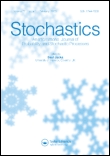
Stochastics-An International Journal of Probability and Stochastic Processes
Advancing Knowledge in Modeling and SimulationStochastics: An International Journal of Probability and Stochastic Processes, published by Taylor & Francis Ltd, is a pivotal platform for the dissemination of innovative research in the realms of probability and stochastic processes. Since its inception in 1975, the journal has evolved to encapsulate a rich array of methodologies and applications, contributing significantly to the fields of modeling, simulation, and statistical analysis. With a current impact factor ranking in the Q3 category for both Modeling and Simulation and Statistics and Probability, it positions itself as a valuable resource for professionals, researchers, and students alike. The journal’s coverage spans a unique historical arc from 1975, and it continues to push boundaries up to 2024, ensuring the latest trends and discoveries are accessible to an engaged audience. Though not Open Access, the journal’s scholarly contributions are crucial for advancing understanding and innovation in stochastic modeling, making it an essential read for those seeking to deepen their expertise in the field.
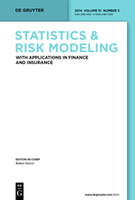
Statistics & Risk Modeling
Empowering research at the intersection of statistics and risk.Statistics & Risk Modeling is a distinguished journal published by WALTER DE GRUYTER GMBH, focusing on the intricate relationships between statistical methodologies and risk assessment techniques. With a strong academic foundation, the journal has been an influential platform in its field since its inception, converging contributions from 1982 to 2002 and again from 2011 to 2024. This journal is currently ranked in the Q3 category in both Modeling and Simulation and Statistics and Probability, reflecting its commitment to advancing knowledge and promoting robust research in statistics, probability, and uncertainty analysis. Although it offers a traditional subscription model, its significant contribution to the community is underscored by its increasing visibility in Scopus rankings, where it stands in the 44th percentile for Decision Sciences and Statistics. By comprehensively addressing contemporary issues in statistical theory and its practical applications, Statistics & Risk Modeling serves as an essential resource for researchers, professionals, and students aiming to deepen their understanding of statistical science and its implications in risk management.

JOURNAL OF FINANCIAL SERVICES RESEARCH
Fostering rigorous research for contemporary financial challenges.The JOURNAL OF FINANCIAL SERVICES RESEARCH, published by SPRINGER, serves as a critical platform for scholarly discourse in the fields of finance, accounting, and econometrics. With a dedicated focus on innovative research and rigorous analysis, this journal has maintained a respectable Impact Factor, placing it in the Q2 category for 2023 across multiple academic disciplines including Accounting, Economics, and Finance. Since its inception in 1987, it has contributed significantly to the advancement of knowledge and practice within financial services, making it essential reading for researchers, professionals, and students alike. The journal is based in the Netherlands and hosts contributions that address contemporary issues in financial systems, markets, and institutions. Despite its non-open access format, the journal remains highly relevant, with Scopus rankings indicating its solid position within its peer group, especially in the realms of Economics, Econometrics, and Finance. As the journal approaches its converged coverage through 2024, it aims not only to disseminate high-quality research but also to foster a deeper understanding of the dynamic financial landscape.

International Review of Finance
Bridging theory and practice in global finance.International Review of Finance is a prestigious academic journal published by Wiley, located in the United Kingdom. With its ISSN 1369-412X and E-ISSN 1468-2443, this journal serves as an essential platform for researchers and practitioners in the fields of Economics and Finance. Ranked in the Q2 quartile for both Economics and Econometrics and Finance as of 2023, it showcases high-quality research that contributes significantly to theoretical and practical advancements. Reflecting its standing, the journal is positioned in the 61st percentile in Economics and Econometrics and the 60th percentile in Finance according to Scopus rankings. The scope of the journal includes a diverse range of topics, encouraging innovative discourse across various financial disciplines. Although it does not offer open access, the International Review of Finance continues to be an important resource for academics, professionals, and students seeking to deepen their understanding of evolving financial theories and practices.

Decisions in Economics and Finance
Exploring Innovative Solutions in EconomicsDecisions in Economics and Finance, published by SPRINGER INT PUBL AG, is a leading journal in the fields of economics, econometrics, and finance, providing a critical platform for researchers, professionals, and students to disseminate their findings and insights. With an impressive impact factor positioned in the Q2 category for both Economics and Finance in 2023, this journal is recognized for its rigorous peer-reviewed process and impactful research contributions. The journal spans over areas of general economics and finance, emphasized by its Scopus rankings, which place it in the 68th and 50th percentiles respectively. Since its inception in 1997 and continuing through its conferred years, Decisions in Economics and Finance continues to foster innovative approaches to economic and financial decision-making while bridging theoretical and practical applications. While it currently does not offer Open Access options, its commitment to quality research and interdisciplinary collaboration makes it a vital resource for anyone engaged in these dynamic fields.

Data Science in Finance and Economics
Catalyzing insights for a data-driven future in finance and economics.Data Science in Finance and Economics is a pioneering journal published by the American Institute of Mathematical Sciences (AIMS), devoted to the intersection of data science with the fields of finance and economics. Established as an open-access journal since 2021, it aims to disseminate high-quality research that unravels complex financial phenomena and economic models through innovative data-driven methodologies. With a commitment to advancing knowledge in this rapidly evolving discipline, the journal encourages submissions that encompass theoretical studies, empirical research, and application-based articles from both academia and industry. While the journal is relatively new, its potential to significantly influence the discourse in finance and economics is profound, offering researchers, professionals, and students an invaluable resource to stay abreast of current trends and methodologies in data science. For access to cutting-edge research and insights, visit AIMS and contribute to the ongoing conversation in this essential field.
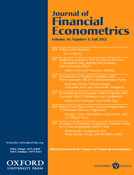
Journal of Financial Econometrics
Exploring the nexus of finance and econometrics.Journal of Financial Econometrics, published by Oxford University Press, stands as a leading academic journal in the fields of financial economics and econometrics. With an impressive impact factor and a ranking in the Q1 quartile for both Economics and Finance categories in 2023, this journal is recognized for its contribution to advancing theoretical and applied methodologies in financial econometric analysis. It publishes high-quality research that addresses critical issues in finance, aiming to foster a deeper understanding of the economic factors influencing financial markets and instruments. Researchers and practitioners alike benefit from its rigorous peer-reviewed articles, which are invaluable resources for both academic scholars and finance professionals. The journal’s content typically spans pioneering techniques in econometric modeling, empirical analysis of financial instruments, and innovative applications of econometric theory in real-world scenarios. Operating out of the United Kingdom, the journal continues to serve as a vital platform for disseminating significant research findings from 2005 to 2024, ensuring that the latest advancements in the field are accessible to its audience.
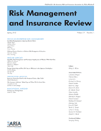
RISK MANAGEMENT AND INSURANCE REVIEW
Pioneering Research in Risk Assessment and Insurance PracticesRISK MANAGEMENT AND INSURANCE REVIEW, published by Wiley, is a vital journal for researchers and practitioners in the fields of accounting, economics, and finance. With an ISSN of 1098-1616 and an E-ISSN of 1540-6296, this journal serves as a comprehensive platform for the dissemination of cutting-edge research and insights into risk management and insurance practices. Although it does not offer an open-access model, it is recognized for its rigorous peer-review process and maintains an impactful presence within the academic community, reflected in its 2023 Scopus rankings in various disciplines, including its Q3 quartile status across multiple categories. The journal's scope addresses key contemporary issues in risk assessment, financial stability, and insurance innovation, contributing significantly to the evolving discourse in these areas. As it converges from 2006 to 2024, RISK MANAGEMENT AND INSURANCE REVIEW continues to attract a diverse readership, providing valuable resources and fostering dialogue among students, professionals, and established researchers alike.

Geneva Risk and Insurance Review
Connecting academia and practice in risk analysis.Geneva Risk and Insurance Review, published by Palgrave Macmillan Ltd, stands as a premier academic journal dedicated to advancing the understanding of risk and insurance through rigorous research and analysis. With an ISSN of 1554-964X and an E-ISSN of 1554-9658, this journal has carved out a notable niche in the fields of Accounting, Business Management, and Finance, as reflected by its 2023 category quartiles and Scopus rankings, positioning it among the top echelons of scholarly output in these disciplines. The journal is renowned for its commitment to open access, enhancing accessibility for a diverse audience of researchers, professionals, and students keen to explore the complexities of risk dynamics. Since its inception in the mid-1970s, and with recent converged years leading up to 2024, it has consistently provided a platform for groundbreaking studies that shape policies and practices in the insurance sector. The journal's reputation for excellence and influential contributions makes it an essential resource for those engaged in the evolving discussions surrounding risk management and insurance strategies.
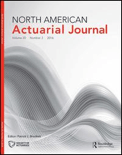
North American Actuarial Journal
Advancing Actuarial Insights for Tomorrow's ChallengesNorth American Actuarial Journal is a prominent publication in the fields of Economics and Econometrics, Statistics and Probability, and Statistics, Probability and Uncertainty, published by Routledge Journals, Taylor & Francis Ltd. The journal, with the ISSN 1092-0277 and E-ISSN 2325-0453, covers critical advancements in actuarial science over the years from 1997 to 2024. With a strong Q2 ranking in multiple categories for 2023, the journal positions itself as a vital resource for researchers and practitioners looking to stay abreast of current trends and methodologies in actuarial practices. The journal’s focus on providing a platform for high-quality research makes it indispensable for professionals and academics alike, offering insightful contributions that influence the actuarial field's evolution. While it currently does not offer open access options, its rigorous peer-review process ensures the integrity and relevance of its published works. Researchers, professionals, and students in actuarial science will find this journal to be a valuable asset for both their studies and professional development.